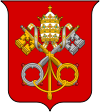Holy See
| Holy See |
 This article is part of the series: |
|
|
|
|
Other countries · Atlas |
The Holy See is the episcopal jurisdiction of the Bishop of Rome, commonly known as the Pope, and is the preeminent episcopal see of the Roman Catholic Church. It is also the sovereign entity, headed by the Pope, which governs the Vatican and represents the Catholic Church in temporal affairs. The Holy See should not be confused with the Vatican City State, which came into existence only in 1929, while the Holy See dates back to early Christian times. Ambassadors are officially accredited not to the Vatican City State but to "the Holy See", and papal representatives to states and international organizations are recognized as representing the Holy See, not the Vatican City State.
While all episcopal sees can be referred to as holy, the expression “the Holy See” (without further specification) is normally used in international relations (as well as in the canon law of the Catholic Church)[1] to refer to the central government of the Catholic Church.
Contents |
Organization
The Pope governs the Catholic Church through the Roman Curia. The Roman Curia consists of a complex of offices that administer church affairs at the highest level, including the Secretariat of State, nine Congregations, three Tribunals, eleven Pontifical Councils, and seven Pontifical Commissions. The Secretariat of State, under the Cardinal Secretary of State, directs and coordinates the Curia. The current incumbent, Cardinal Tarcisio Bertone, is the See's equivalent of a prime minister. Archbishop Dominique Mamberti, Secretary of the Section for Relations with States of the Secretariat of State, acts as the Holy See's foreign minister. Bertone and Mamberti were named in their respective roles by Pope Benedict XVI in September 2006.
The Secretariat of State is the only body of the Curia that is situated within Vatican City. The others are in buildings in different parts of Rome that have extraterritorial rights similar to that of embassies.
Among the most active of the major Curial institutions are the Congregation for the Doctrine of the Faith, which oversees the Catholic Church's doctrine; the Congregation for Bishops, which coordinates the appointment of bishops worldwide; the Congregation for the Evangelization of Peoples, which oversees all missionary activities; and the Pontifical Council for Justice and Peace, which deals with international peace and social issues.
Three tribunals are responsible for judicial power. The Sacra Rota is responsible for normal appeals, including decrees of nullity for marriages, with the Apostolic Signatura being the administrative court of appeal and highest ecclesiastical court. The Apostolic Penitentiary is different from those two and, instead of dealing with contentious cases, issues absolutions, dispensations, and indulgences.
The Prefecture for the Economic Affairs of the Holy See coordinates the finances of the Holy See departments and supervises the administration of all offices, whatever be their degree of autonomy, that manage these finances. The most important of these is the Administration of the Patrimony of the Apostolic See.
The Prefecture of the Papal Household is responsible for the organization of the papal household, audiences, and ceremonies (apart from the strictly liturgical part).
The Holy See does not dissolve upon a Pope's death or resignation. It instead operates under a different set of laws sede vacante. During this interregnum, the heads of the dicasteries of the Roman Curia (such as the prefects of congregations) cease immediately to hold office, the only exceptions being the Major Penitentiary, who continues his important role regarding absolutions and dispensations, and the Cardinal Camerlengo, who administers the temporalities (i.e., properties and finances) of the See of St. Peter during this period. The government of the See, and therefore of the Catholic Church, then falls to the College of Cardinals. Canon law prohibits the College and the Camerlengo from introducing any innovations or novelties in the government of the Church during this period.
The terms “Holy See” and “Apostolic See”
Every episcopal see is considered holy. In the East, the adjective “holy” or “sacred” (ἱερά) is constantly applied to all such sees as a matter of course. In the West, the adjective is not commonly added, but it does form part of an official title of two sees: as well as Rome, the Bishopric of Mainz (the former Archbishopric of Mainz), which was also of electoral and primatial rank, bears the title of “the Holy See of Mainz” (Latin: “Sancta Sedes Moguntina”).
The term “Apostolic See” can refer to any see founded by one of the Apostles, but, when used with the definite article, it is used in the Catholic Church to refer specifically to the see of the Bishop of Rome, whom that Church sees as successor of Saint Peter, the chief of the apostles.
References
Further reading
Books
- La Due, William J. The Chair of Saint Peter: A History of the Papacy. (ISBN 1-57075-249-4)
- Heribert Franz Koeck, Die völkerrechtliche Stellung des Heiligen Stuhls. Dargestellt an seinen Beziehungen zu Staaten und internationalen Organisationen, Berlin 1975
- Heribert Franz Koeck, Holy See, in: Encyclopedia of Public International Law, Bd. 2, Oxford etc. 1995
External links
- The Holy See Website
- Primacy of the Apostolic See
- CIA World Factbook on Holy See
- Between Venus and Mars, the Church of Rome Chooses Both - The Holy See’s geopolitics analyzed in the light of the dominant doctrines
- The Holy See in the course of time, from an Orthodox perspective
|
|||||||
|
|||||||||||
|
|||||||||||